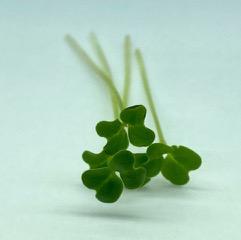Cruciferae Brassica Juncea Oriental
Wasabi, Adds a kick of flavor & spice
Vitamins A, B, C, E & K
Calcium, Iron, Magnesium, Phosphorus, Potassium, Zinc
Carotene, Chlorophyll,
Antioxidants, Amino Acids, Trace Elements
A microgreen is a tiny vegetable green with a wide range of flavors, colors and textures. Smaller than baby greens but harvested later than sprouts, they range in size from 1” to 3” including the stem and leaves. A microgreen has a single central stem, fully developed cotyledon leaves and one pair of very small, partially developed true leaves. Microgreens enhance the beauty, taste and freshness of dishes with their delicate textures and distinctive flavors. Edible young greens and grains are produced from various kinds of vegetables, herbs or other plants and are good for garnishing salads, soups, plates, and sandwiches, used in omelets, shakes and stir-fry.
Microgreens are an excellent way to add nutrients to your diet. They pack a lot of flavor and can have between 4 to 40 times more vitamins, minerals, antioxidants and beneficial properties than the equivalent product grown to maturity. Nutrition researchers at the USDA Agricultural Research Service have published several studies that identify the nutritional make-up and the shelf life of microgreens. Twenty-five varieties were tested, key nutrients measured were ascorbic acid (vitamin C), tocopherols (vitamin E), phylloquinone (vitamin K), and beta-carotene (a vitamin A precursor), plus other related carotenoids in the cotyledons. Among the 25 microgreens tested, red cabbage, cilantro, garnet amaranth, and green daikon radish had the highest concentrations of vitamin C, carotenoids, vitamin K, and vitamin E, respectively. In general, microgreens contained considerably higher levels of vitamins and carotenoids—about five times greater—than their mature plant counterparts, an indication that microgreens may be worth the trouble of delivering them fresh during their short lives. A nutritional study of microgreens was done in the summer of 2012 by the Department of Nutrition and Food Science at the University of Maryland, indicated promising potential that microgreens may indeed have particularly high nutritional value compared to mature vegetables.
Microgreens give us the comfort of knowing they contain no additives like pesticides. The plants only are grown for a few days, so you can feel quite good about knowing your not consuming anything harmful from microgreens. All About Fresh grows from certified organic, fully tested seed without soil, using a filtered water source and no chemicals of any kind. All food grade plastics are used where necessary. All packaging is biodegradable/recyclable &/or compostable.
Microgreens provided convenience as they require minimum handling, and prefer to be added to your dishes in a fresh, unprocessed state. Saving time from peeling, chopping and cleanup.
Microgreens go with everything. They are just plain easy. Some may enjoy eating fresh microgreens because of their essential nutrients and unique flavors from mild to intense. Sauté them or air fry them. Throw them in a shake or add them to an egg. Garnish soup or pile them on a sandwich. Add them to a salad, or use them as a salad!
Wash before consumption. Suggested with a spray of FOOD GRADE hydrogen peroxide, a quick rinse and spin in a mesh spinner or lay out on a clean towel to dry some.
Larger quantities: inquire contact@AllAboutFresh.com


